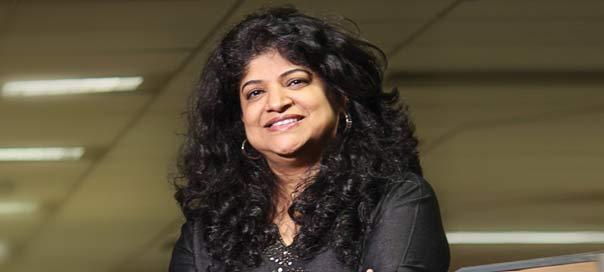Nandini Dias, CEO of Lodestar UM India, talks about crafting genuine strategy to enable brands to win in the marketplace, the ‘Better Science, Better Art and Better Outcomes’ philosophy, and focus areas to keep pace with the changing mediascape
By Srabana Lahiri
Nandini Dias, CEO of Lodestar UM India, is as straightforward as anyone can be. At the helm of an agency business with an estimated size of Rs 5000 crore, Dias is clear that her aim is not to “pitch blindly and win more clients”, but pitch for limited business, settle those businesses well and only then look at new ones. “We need to be true to our existing clients. Existing clients mean a lot to me,” says Dias, known for her deep associations formed over the years with long-standing clients.
Not that the agency lags in the area of winning new business: Dias herself talks about adding marquee accounts such as Samsung and Johnson & Johnson to the agency’s roster of clients - that includes the likes of Amul, Coca-Cola, Mahindra & Mahindra and Nerolac - in the same breath as she talks about the difficulty of getting talent and grooming them to understand the larger picture, which she calls “a bigger struggle than getting new business”.
MANAGEMENT: THE NEXT LEVEL
Until Dias became the CEO, Lodestar UM thrived on a dual COO structure, with Dias heading Mumbai operations and Anamika Mehta heading the Delhi office. That system continues: Hema Malik is the COO in Delhi, while Vaishali Verma is COO of Bangalore. And a Mumbai COO is likely to be announced in a short time. Kolkata, Cochin and Chennai are under one of these COOs.
Dias says her “biggest responsibility” is to get internal and external stakeholders comfortable with the idea of the next level of senior management talent at Lodestar UM. “Whether it is the COOs or Aditi Mishra, custodian and head of strategic product, or the several business heads in Mumbai… I have to ensure that they start front-ending the company’s policies, practices and performance with clients and the industry,” Dias says, adding that like all good organizations, there is a matrix structure. Though there are client-specific units, work is usually a combination of location-based servicing of clients with the expertise of a central hub of senior resources drawn from all over.
“Aditi Mishra is in charge of ‘Better Science’ and is a central resource. Similarly, Dhruv Jha who is in charge of ‘Better Art’ is central to all. In addition to specialist heads, there are location heads and business heads who are in full charge of our philosophy - Better Science, Better Art and Better Outcomes,” Dias explains.
Q&A ‘We bring tomorrow’s media to the market today’
STAYING AHEAD IN THE RACE
Dias banks on the media agnostic Strategy First approach as a differentiator for Lodestar UM. “We start from strategy and planning as opposed to trading and buying. The focus ensures that we are dynamic and agile. The approach is purist in a sense: ‘I want to do what’s strategically correct for the brand’ and becomes imperative as there is no other consideration in sight,” says Dias. “If the mindset is let’s do what is right for the brand by strategy, then what they require is what we will buy as opposed to what we already bought. You will never find my planners trying to sell a certain inventory because it has already been bought. You will never find them saying, ‘Okay, we will get you this 10% cheaper if you commit at the beginning of the year’.”
Globally, Lodestar UM has rounded up the ideas that will excite media planners for the coming year: new technologies, market forces, and shifts in consumer behaviour that are changing the media landscape. According to Dias, in the next couple of years, Lodestar UM India will be focused on:
• Conversational Interfaces: Devices interacting with people using natural language via voice or text input. These conversational interfaces will power the next wave of computing as it spreads to homes, cars, and human bodies, dramatically altering search and discovery.
• Applified TV: As consumers shift to Internet-based delivery, the source of video content is becoming abstracted, as television gains the benefits of digital. We’re rapidly shifting from a strict programming grid to search and feed-based discovery, in the living room and across our devices. Appification renders the choice of device a moot point. It will also enable new interactive ad formats, direct-response commercials, and integration with mobile couponing and loyalty programmes.
• Boundless Retail: Allows consumers continuous access to sellers who build relationships through multiple touch-points and channels
• Ad Avoidance: Consumers are provided with increasing options to avoid ads across all media types.
“The mobile ecosystem is enabling brick-and-mortar retail to gain many of the benefits of digital, including closed-loop attribution, mobile payments and loyalty programmes, and CRM systems that encompass the entire purchase cycle. Shopping is more than just buying, and for years customers have used a combination of digital and physical shopping to the greatest benefit, relying on physical retail for experience and curation, and ecommerce for ease of use,” says Dias.
“We will offer strategy and thought leadership to contextualize these developments within the larger technology, media, and marketing landscape. The focus of our business is to apply all of this knowledge, learning, and experience to solving client briefs,” she adds.
 @ FEEDBACK: srabana@exchange4media.com
@ FEEDBACK: srabana@exchange4media.com

























